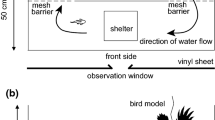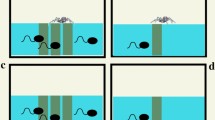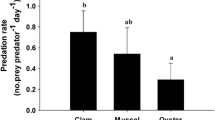Abstract
The indirect, non-lethal results of predation, such as reduction in feeding time or restraint in seeking sexual partners and/or natural resources, have a drastic effect on prey populations. In this study, we investigated the behaviour of two serpa tetras Hyphessobrycon eques groups, one wild and the other born and raised in captivity, to evaluate how their feeding behaviour is affected by the avian predator, the rufescent tiger-heron Trigrisoma lineatum (using a taxidermy specimen). For a total of 133 observation hours, the feeding behaviour of each fish group was observed according to the absence (control) or presence (treatments) of a predator near the aquarium surface. The results showed that the presence of a predator on the surface inhibits the feeding behaviour of H. eques. The differences observed between the groups are probably due to the fishes’ experiences with predators. Our results suggest that fish-eating birds may affect prey populations in streams and ponds perhaps more through non-lethal effects, on feeding behaviour for example, than directly through death rates.
Similar content being viewed by others
References
Allouche S, Gaudin P (2001) Effects of avian predation threat, water flow and cover on growth and habitat use by chub, Leuciscus cephalus, in an experimental stream. Oikos 94:481–992
Altmann J (1974) Observational study of behaviour: sampling methods. Behaviour 49:227–267
Bachman GC (1993) The effect of body condition of the tradeoff between vigilance and foraging in Belding’s ground squirrels. Anim Behav 46:233–244
Britski HA, Silimon KZ de S, Lopes BS (1999) Peixes do Pantanal. Manual de identificação. Embrapa-SPI/Embrapa-CPAP, Brasília/Corumbá
Casatti L, Mendes HF, Ferreira KM (2003) Aquatic macrophytes as feeding site for small fishes in the Rosana Reservoir, Paranapanema River, Southeastern Brazil. Braz J Biol 63:1–8
Endler JA (1986) Defense against predators. In: Feder ME, Lauder GV (eds) Predator–prey relationships. Perspectives and approaches from the study of lower vertebrates. University of Chicago Press, Chicago, pp 109–134
Helfman GS (1986) Behavioural responses of prey fishes during predator–prey interactions. In: Feder ME, Lauder GV (eds) Predator–prey relationships. Perspectives and approaches from the study of lower vertebrates. University of Chicago Press, Chicago, pp 135–156
Kohler SL, Mcpeek MA (1989) Predation risk and the foraging behaviour of competing stream insects. Ecology 70:1811–1825
Lima SL (1998) Nonlethal effects in the ecology of predator–prey interactions. Bioscience 48:25–34
Magurran A, Seghers BH (1990) Population differences in predator recognition and attack cone avoidance in the guppy Poecilia reticulata. Anim Behav 40:443–452
Milinski M, Heller R (1978) Influence of a predator on the optimal foraging behaviour of sticklebacks (Gasterosteus aculeatus L.). Nature 275:642–644
Nakatani K, Agostinho AA, Baumgartner G, Bialetzki A, Sanches PV, Makrakis MC, Pavanelli CS (2001) Ovos e larvas de peixes de água doce: desenvolvimento e manual de identificação. Maringá, EDUEM
Petterson LB, Brönmark C (1993) Trading off safety against food: state dependent habitat choice and foraging in crucian carp. Oecologia 95:353–357
Power ME (1983) Grazing responses of tropical freshwater fishes to different scales of variation in their food. Environ Biol Fish 9:103–115
Power ME (1984) Depth distributions of armoured catfish: predator-induced resource avoidance? Ecology 65:523–528
Power ME, Dudley TL, Cooper SD (1989) Grazing catfish, fishing birds and attached in a panamanian stream. Environ Biol Fish 26:285–294
Sazima I (1986) Similarities in feeding behaviour between some marine and freshwater fishes in two tropical communities. J Fish Biol 29:53–65
Sazima I, Machado FA (1990) Underwater observations of piranhas in Western Brazil. Environ Biol Fish 28:17–31
Sick H (1997) Ornitologia brasileira. Nova Fronteira, Rio de Janeiro
Siegel S (1981) Estatística não-paramétrica, para as ciências do comportamento. McGraw-Hill, São Paulo
Trajano E (1989) Estudo do comportamento espontâneo e alimentar e da dieta do bagre cavernícola, Pimelodella Kronei, e seu provável ancestral epígeo, Pimelodella transitoria (Siluriformes, Pimelodidae). Braz J Biol 49:757–769
Trippia MCBP (1998) L’ influence de l’ alimentation sur le développement des gonades et analyse morphologique de la maturation du Hyphessobryconcallistus et du Trichogaster trichopterus (Pisces Teleostei). Arch Vet Sci 3:101–114
Trippia MCBP (1999) L’ influence de l’ alimentation et de la densité de la population sur le développement des gonades chez trois espèces de poissons. Arch Vet Sci 4:81–87
Weitzman SH, Palmer L (1998) Phantom tetras: a brief account of their ichthyological and aquarium history. Trop Fish Hobbyist XLVI:124–132
Acknowledgements
This study was made possible by the support of FAPEMIG (Grant number 125/96 and CRA 1267/03) and CNPq (Grant number 522168/95-7). We wish to thank Ricardo Macedo Correa e Castro and Lilian Casatti for their helpful comments on the manuscript. All experiments comply with the Brazilian legislation.
Author information
Authors and Affiliations
Corresponding author
Additional information
Communicated by R.F. Oliveira
Rights and permissions
About this article
Cite this article
Carvalho, L.N., Del-Claro, K. Effects of predation pressure on the feeding behaviour of the serpa tetra Hyphessobrycon eques (Ostariophysi, Characidae). acta ethol 7, 89–93 (2004). https://doi.org/10.1007/s10211-004-0093-1
Received:
Revised:
Accepted:
Published:
Issue Date:
DOI: https://doi.org/10.1007/s10211-004-0093-1




